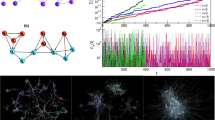Abstract
We develop a mathematical model for the energy landscape of polyhedral supramolecular cages recently synthesized by self-assembly (Sun et al. in Science 328:1144–1147, 2010). Our model includes two essential features of the experiment: (1) geometry of the organic ligands and metallic ions; and (2) combinatorics. The molecular geometry is used to introduce an energy that favors square-planar vertices (modeling \(\mathrm {Pd}^{2+}\) ions) and bent edges with one of two preferred opening angles (modeling boomerang-shaped ligands of two types). The combinatorics of the model involve two-colorings of edges of polyhedra with four-valent vertices. The set of such two-colorings, quotiented by the octahedral symmetry group, has a natural graph structure and is called the combinatorial configuration space. The energy landscape of our model is the energy of each state in the combinatorial configuration space. The challenge in the computation of the energy landscape is a combinatorial explosion in the number of two-colorings of edges. We describe sampling methods based on the symmetries of the configurations and connectivity of the configuration graph. When the two preferred opening angles encompass the geometrically ideal angle, the energy landscape exhibits a very low-energy minimum for the most symmetric configuration at equal mixing of the two angles, even when the average opening angle does not match the ideal angle.







Similar content being viewed by others
Notes
The tolerance is the width of the Gaussian distribution of random test displacements applied to the vertices in each dimension; we use successively smaller tolerances, and end the annealing process when the evolution of the total energy at the lowest tolerance has a sufficiently small average slope, the threshold slope set by trial and error to balance accuracy with efficiency.
We could also use the symmetry between ‘red’ and ‘blue’ by ending the process when we have enumerated all configurations with \(m=n=12\), and finding the graph for \(m>n\) by swapping the colors of every edge; we choose instead to continue the process to \(m=2n=24\) in order to corroborate the correctness of our algorithm by comparing the results for m and \(2n-m\). The time necessary is not prohibitive; the full calculation took about 12.5 h on a 2012 MacBook Pro laptop.
In Fig. 6a, we calculate the energy for configurations with \(s=3\) only for \(m\le 8\) and \(m\ge 40\), and for a larger proportion of configurations with \(s=2\) for \(m\le 8\), \(m\ge 40\), \(m=11,13,17,31,35,37\).
References
Caspar, D.L.D., Klug, A.: Physical principles in the construction of regular viruses. In: Chovnick, A. (ed.) Cold Spring Harbor Symposia on Quantitative Biology vol. 27, pp. 1–24. Cold Spring Harbor Laboratory Press, Long Island, NY (1962)
Cates, M.E., Manoharan, V.N.: Testing the Foundations of Classical Entropy: Colloid Experiments. arXiv:1507.04030 (2015)
Coxeter, H.S.M.: Regular Polytopes. Dover Publications, New York (1973)
Holmes-Cerfon, M., Gortler, S.J., Brenner, M.P.: A geometrical approach to computing free-energy landscapes from short-ranged potentials. Proc. Natl. Acad. Sci. 110, E5–E14 (2013)
Johnson, D., Menon, G.: The Building Game: From Enumerative Combinatorics to Conformational Diffusion. Preprint (2015)
Kaplan, R., Klobušickỳ, J., Pandey, S., Gracias, D.H., Menon, G.: Building polyhedra by self-assembly: theory and experiment, Artif. Life 20, (2014)
Liu, Y., Hu, C., Comotti, A., Ward, M.D.: Supramolecular Archimedean cages assembled with 72 Hydrogen bonds. Science 333, 436–440 (2011)
Mal, P., Breiner, B., Rissanen, K., Nitschke, J.R.: White phosphorus is air-stable within a self-assembled tetrahedral capsule. Science 324, 1697–1699 (2009)
Pandey, S., Ewing, M., Kunas, A., Nguyen, N., Gracias, D.H., Menon, G.: Algorithmic design of self-folding polyhedra. Proc. Natl. Acad. Sci. 108, 19885–19890 (2011)
Rotman, J.J.: An Introduction to the Theory of Groups. Graduate Texts in Mathematics, vol. 148, 4th edn. Springer-Verlag, New York (1995)
Sun, Q.F., Iwasa, J., Ogawa, D., Ishido, Y., Sato, S., Ozeki, T., Sei, Y., Yamaguchi, K., Fujita, M.: Self-assembled \({M}_{24}{L}_{48}\) polyhedra and their sharp structural switch upon subtle ligand variation. Science 328, 1144–1147 (2010)
Sun, Q.F., Sato, S., Fujita, M.: An m12(l1)12(l2)12 cantellated tetrahedron: a case study on mixed-ligand self-assembly. Angew. Chem. Int. Ed. 53, 13510–13513 (2014)
Takeda, N., Umemoto, K., Yamaguchi, K., Fujita, M.: A nanometre-sized hexahedral coordination capsule assembled from 24 components. Nature 398, 794–796 (1999)
Author information
Authors and Affiliations
Corresponding author
Additional information
Communicated by Robert V. Kohn.
ERR acknowledges the support and hospitality of the Institute for Computational and Experimental Research in Mathematics (ICERM) at Brown University, where she was a postdoctoral fellow while carrying out this work. GM acknowledges partial support from NSF grant DMS 14-11278. This research was conducted using computational resources at the Center for Computation and Visualization, Brown University.
Rights and permissions
About this article
Cite this article
Russell, E.R., Menon, G. Energy Landscapes for the Self-Assembly of Supramolecular Polyhedra. J Nonlinear Sci 26, 663–681 (2016). https://doi.org/10.1007/s00332-016-9286-9
Received:
Accepted:
Published:
Issue Date:
DOI: https://doi.org/10.1007/s00332-016-9286-9




